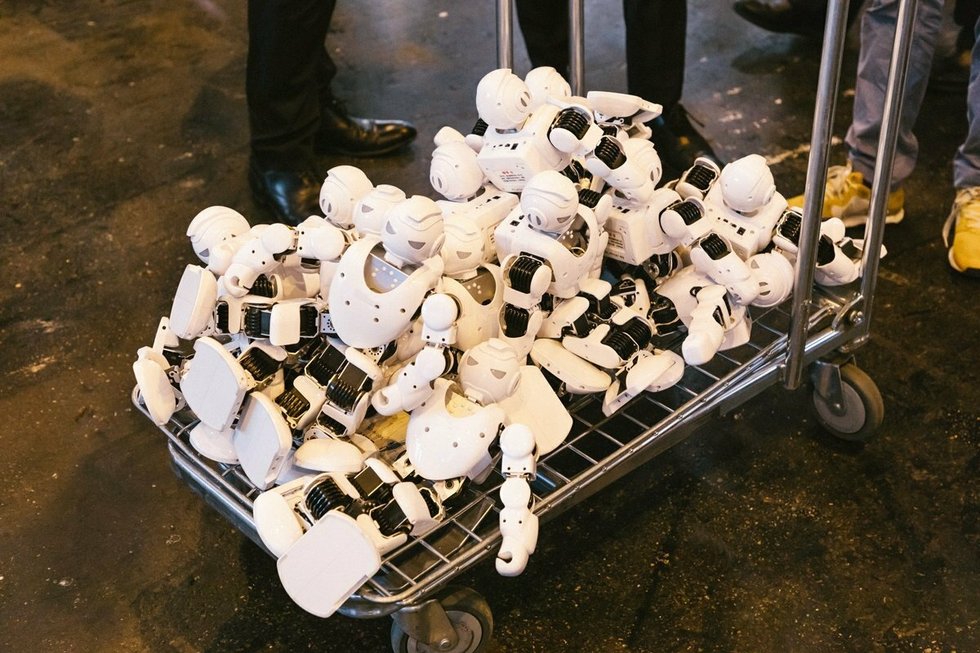Futureproof: 9 rules for humans in the age of automation
Jun 24, 2021
9 mins


Do artificial intelligence and automation destroy jobs? This question has fuelled a debate between techno-pessimists and techno-optimists for centuries. When 19th-century English textile workers —the so-called Luddites—vandalized the weaving machinery they accused of taking away their jobs, they started a movement to oppose technology and to remove its power to wreck jobs. Techno-optimists have countered their position by insisting that more new jobs are always created in the end. Is it going to be any different this time?
What’s certain is that AI has already profoundly changed the way we live and work. What used to be a subject for sci-fi authors is now part of our daily lives. It shapes our purchasing decisions, our political views, and the relationships we form. Sometimes it seems that we are driven and shaped by machines at least as much as we drive and shape them. “How can we be happy, successful humans in a world that is increasingly built by and for machines?” asks Kevin Roose in his new book Futureproof: 9 Rules for Humans in the Age of Automation.
A New York Times technology columnist for years, Roose started off as a techno-optimist, but his own smartphone addiction, the polarization of politics and the way AI amplifies existing biases and makes the weak more vulnerable have slowly made him more skeptical and cautious when it comes to technology. He is convinced we need to make a number of changes to protect our own futures and to focus on being more human. In this thoughtful book, he lays out nine rules for humans to thrive in the age of automation. These include individual as well as collective solutions. Despite the accelerating tech backlash, AI could still help us to improve our work and our lives. But humans need to be in the driver’s seat and to become hyper-vigilant about the ethical, social, and environmental consequences of automation.
“AI optimists are broadly correct in claiming that new technology enhances our quality of life in the aggregate . . . But what the optimists miss is that we don’t live in the aggregate, or over the long term. We experience major economic shifts as individuals with finite careers and lifespans, and for many people, technological change hasn’t always resulted in better material conditions during their lives.” -Kevin Roose in Futureproof: 9 Rules for Humans in the Age of Automation
Why more people are becoming wary of machines
Silicon Valley engineers have long defended the narrative that AI and automation can improve lives and save the world. When it comes to the future of work, they argue that throughout history Luddites have always been proved wrong. But for a few years, this narrative has been increasingly criticized. “As I studied the history of technological change, I realized that some of the stories technologists liked to tell—like the narrative that technology has always created more jobs than it destroyed, or that humans and AI would collaborate rather than compete with one another—turned out to be, if not false, then at least radically incomplete,” Roose writes.
Over the years he started to notice a gap between the promises of technology and the reality as lived by the regular people using it. Clearly it’s not making everybody’s life better and it’s even greatly contributed to such problems as the spreading of misinformation and the alienation of workers. After spending time with so many of the people designing the tech, Roose became disillusioned about their very intentions: “When the cameras and microphones were off, these executives weren’t talking about helping workers. They were fantasizing about getting rid of them completely.”
Naive techno-optimism has become harder to sustain and the public conversation around AI has become more and more pessimistic. Public figures such as Andrew Yang, who ran in the 2020 US Democratic presidential primaries and is running for mayor of New York City in 2021, argues that people need a monthly “freedom dividend” (basic income) to “cushion the blow of automation”. The Covid-19 pandemic made this proposition timelier as automation was accelerated: “The pandemic gave companies the cover they needed to make huge, unprecedented strides in automation without risking a backlash. So they automated, and automated, and automated some more.”
Why AI optimists are not quite right this time
There are four claims usually made by the techno-enthusiasts. The first is that technology has always eventually created more jobs than it destroyed. The second claim is that AI can help to make all jobs better by eliminating the most boring, repetitive tasks. The third idea is that AI and humans collaborate much more than they compete. And the fourth is that because human needs are limitless, we’ll always come up with new jobs that can’t yet be imagined. Although Roose doesn’t entirely refute these claims, he doesn’t fully agree with them either. He analyzes each one of these claims with caution.
The optimists aren’t right with their first claim. When you look at the first industrial revolutions, you’ll see that it generally took decades before workers had good jobs with decent working conditions. “History suggests that while periods of technological change often improve conditions for elites and capital owners, workers don’t always experience the benefits right away. After the onset of the Industrial Revolution in the 1760s, Britain’s corporate profits soared almost immediately, but it took more than fifty years for the real wages of British workers to rise.” Likewise today’s AI and automation tend to disproportionately affect people in low-income occupations and amplify existing gender, social and racial inequalities.
As for the second claim, it is naive at best. For sure there is plenty of liberating automation. But there’s ample evidence that AI makes work much worse for many people. AI has led to the creation of many boring jobs, as seen with the armies of low-paid contractors who “sift through objectionable content all day” for YouTube and Facebook. Furthermore, the more labor-saving solutions we have, the higher the stress at work. “This seeming paradox—that we are not getting happier at work, despite the fact that our jobs are safer and less grueling than ever—may be explained by the observation that in addition to removing hard physical labor, automation can strip away the fun, rewarding parts of jobs that workers actually enjoy.”
Roose also questions the third claim that AI and humans always work best together. Two decades ago chess champion Gary Kasparov insisted that hybrid teams of computers and chess masters could beat any AI. But this no longer seems to be true. Now the best AI will beat any hybrid team. “In these human-AI partnerships we’ve heard so much about, we’re often dead weight.”
Last but not least, it may actually be true that human needs are limitless and that new jobs will be created tomorrow that can’t be imagined today. But there are many issues attached as these jobs may be in different geographies or concern people with different educational backgrounds. The fact that jobs are created somewhere doesn’t mean that the people who lost theirs can have them. Also the new jobs can be poorly paid. How will the wealth be shared? That’s one of the most relevant questions to ask.
Algorithmic managers and boring bots create Kafkaesque nightmares
“In many of today’s workplaces, AI has been promoted to middle management. In industries from customer service to banking and food service, the software now does the supervisory work of training workers, monitoring quality, and reviewing performance—all tasks that used to fall to humans.” Alas this form of management tends to amplify the alienation experienced by workers. A few years ago Uber drivers managed to “reverse engineer” the algorithms by coordinating their actions outside the platform, but by and large most workers find it hard to manipulate the software and certainly can’t negotiate with it.
Roose is particularly wary of what he calls the “boring bots”. They may not look like deadly cyborgs from the future but they are no less dangerous. They automate what no one sees and put the fates of vulnerable people at risk. “These systems can create Kafkaesque nightmares for people trying to figure out why an algorithm kicked them off Medicaid or took away their food stamps.” As explained by Virginia Eubanks in Automating Inequality: putting people at the mercy of bureaucratic algorithms, with little human oversight “shatters the social safety net, criminalizes the poor, intensifies discrimination, and compromises our deepest national values”.
9 rules for humans in the age of automation
“The key to living a happy, rewarding life in the age of AI and automation is not competing with machines head-on—learning to code, optimizing your life, eliminating all forms of personal inefficiency and waste—but strengthening your uniquely human skills, so you’re better equipped to do the things machines can’t do.” Roose lists nine critical rules to thrive in this day and age:
Be surprising, social, and scarce
Humans are much better at handling surprises and functioning in environments with too little information and a lot of uncertainty. Their “common sense” and initiative can make them efficient even with poorly defined rules. Therefore, says Roose, humans need to cultivate this difference. Also humans are better at meeting our social needs: we are social beings who seek relationships with one another. Last but not least, “humans are much better than AI at work that involves unusual combinations of skills, high-stakes situations, or extraordinary talent. I call this type of work ‘scarce’.” The skills you need to try to develop consist in connecting with others, combining things creatively (math and zoology, graphic design and folk music) and generating emotional catharsis.Resist machine drift
There are external forms of automation but there’s also internalized automation happening inside us. The author tells of his smartphone addiction and how he realized that he had become his phone’s slave as he used to compulsively check his notifications hundreds of times every day. He began to notice that the recommendations generated by the algorithms in his apps were turning him into someone shallow and predictable. “I started calling this feeling ‘machine drift’”. The discipline of “choice architecture” relies on the idea that humans can be programmed to make some decisions, notably purchasing decisions. To resist machine drift, it’s best to avoid the “tyranny of convenience” and to seek more autonomy.Demote your devices
To cure his phone addiction Roose realized he needed to have regular moments in his life that would be entirely without screens, which significantly improved his social life as he stopped “phubbing” people. Phubbing is a portmanteau of phone and snub referring to the behavior that consists in snubbing the people you’re with by looking at your phone instead. “Studies have shown that phubbing—or merely having our phones near us while we’re interacting with other people—makes it harder for us to have enjoyable experiences with other people.” Demoting your devices doesn’t mean getting rid of them entirely but it means not letting them control you. “Your life is what you pay attention to,” Roose’s coach told him as he was trying to free himself from his addiction.Leave handprints
In the age of AI and automation, hustling (working really hard as a primary source of identity) is generally counterproductive: you can never outwork an algorithm. You should refuse to compete with machines and instead “focus on leaving [your] own, distinctively human mark on the things [you]’re creating”. Artists and artisans have a better chance of success in the future of work. “Internalizing the handprints principle—which says that the more obvious the human effort behind something, the higher its perceived value—is a crucial part of preparing for the future.” In concrete terms, it means you should be as human as possible in your work and strive to express your uniqueness at work. Make your work personal and authentic.Don’t be an endpoint
People whose jobs consist of taking directions from a machine or serving as a bridge between incompatible machines are “endpoints”. For Roose, you should avoid that at all costs because endpoints are not valued and will ultimately be automated. On the one hand, there are relatively harmless “machine-assisted jobs” where workers are supported by machines. On the other hand, there are “machine-managed jobs” where humans are merely gap-fillers (like gig workers for companies such as Uber and Lyft or Amazon warehouse workers). If you’re managed by a machine, then you’re probably also producing data to help it to find a way to replace you soon. “Put yourself in positions where you can express your humanity, and where there can be no mistaking you for a robot.”Treat AI like a chimp army
AI relies on brute computational force but it’s dumber than a chimp. Roose tells the story of a salesperson who automated the generation of fun sentences to print on T-shirts and ended up with offensive T-shirts that cost him his business. Don’t over-automate. In other words, don’t give machines authority that they’re not meant to handle. “Today, most AI is similar to an army of chimps. It’s smart but not as smart as humans. It can follow directions if it has been properly trained and supervised, but it can be erratic and destructive if it hasn’t.” Without human oversight, AI can make disastrous mistakes. This has a huge impact on marginalized people because the data used to train the algorithms comes from historical sources that are biased.Build big nets and small webs
Big nets are large-scale programs and policies that support people in a world of uncertainty and transitions. Unemployment benefits, life-long training programs, universal healthcare systems, and UBI (universal basic income) are examples of “big nets”. By contrast, “small webs” are local networks of people who support one another in times of hardship. “Historically, big nets have made it easier for societies to adapt to technological change. We also need to think about the small webs we can create to support each other through this technological transition”.Learn machine-age humanities
Roose draws a list of skills he believes are necessary for the new age, which he calls “machine-age humanities”. These include “attention guarding” and “room reading”. The first describes the ability to direct your attention and to tune out external distractions. Meditation, nature walks and breathing exercises can help to develop this skill. “Room reading” describes the ability to understand what people are thinking and how they feel just by “reading a room”. Women and racial minorities tend to have developed this ability more because they’re used to code-switching and modulating their behavior in workplaces dominated by white men. The list also includes the ability to rest and thus fuel one’s creativity. Last but not least, there’s digital discernment ie the capacity to figure out what’s true and false, and analog ethics, which is treating other people well and acting ethically.Arm the rebels
“History shows us that those who simply oppose technology, without offering a vision of how it could be made better and more equitable, generally lose.” Technological abstinence might be the choice of a few artists but it’s rarely the answer to our problems. We all need to engage with potentially harmful systems so as to influence their design.
Photo: Welcome to the Jungle
Follow Welcome to the Jungle on Facebook, LinkedIn, and Instagram, and subscribe to our newsletter to get our latest articles every day!

More inspiration: Laetitia Vitaud
Future of work author and speaker

Age does matter, at work and in the White House
What we've learned from the 2024 presidential elections about aging at work.
Sep 09, 2024

Can companies avoid a brain drain as retirements surge?
Bye bye, Baby Boomers. Hello, knowledge exodus?
Jun 12, 2024

Workplace anxiety: Navigating the future of work in an anxious world
Anxiety has taken center stage in our modern world. How is it shaping the future of work? And most of all, what can we do about it?
May 20, 2024

Why recruiters should hire more ex-freelancers
While freelance and salaried work can seem worlds apart, they may have more in common than you think.
May 02, 2024

How women over 50 are reinventing their careers and the future of work
Women in their 20s struggle to be taken seriously, while middle-aged women battle discrimination... So how are women over 50 reinventing the wheel?
Apr 02, 2024
Inside the jungle: The HR newsletter
Studies, events, expert analysis, and solutions—every two weeks in your inbox

